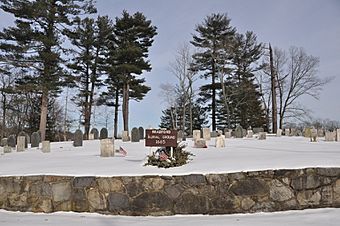Bradford Burial Ground facts for kids
Quick facts for kids |
|
|
Bradford Burial Ground
|
|
 |
|
| Location | 326 Salem Street, Haverhill, Massachusetts |
|---|---|
| Area | 1.5 acres (0.61 ha) |
| Built | 1665 |
| NRHP reference No. | 15000351 |
| Added to NRHP | June 15, 2015 |
The Bradford Burial Ground is a very old cemetery located at 326 Salem Street in the Bradford part of Haverhill, Massachusetts. It was started way back in 1665, making it one of the oldest places in the area where people were buried. This historic cemetery covers about 1.5 acres and holds many stories from the past. It was added to the National Register of Historic Places in 2015 because of its important history.
Contents
Exploring the Bradford Burial Ground
The Bradford Burial Ground is found southeast of the main part of Bradford village. It sits on the north side of Salem Street, a road that connects Bradford to Georgetown. You can find it right across from Orchard Hill Road. It is also next to the drive for the Bradford Swim Club.
What Does the Cemetery Look Like?
The cemetery is shaped a bit like a five-sided figure. A strong stone wall stands at the front, with a small set of granite steps for you to enter. The other sides of the cemetery are marked by walls made of fieldstone. The ground inside is mostly flat, but it slopes gently downhill towards the north. It's a grassy area with many old, tall trees.
Graves and Their Stories
Most of the graves in the cemetery face generally towards the east. However, this isn't always exact, and one row of graves faces north. The very oldest graves are located in the easternmost part of the cemetery.
Even though some areas don't have grave markers, special ground-penetrating radar was used. This radar helped find at least 100 possible grave sites that don't have headstones. The most recent burials in this cemetery happened in the 1950s.
A Glimpse into Bradford's Past
The Bradford Burial Ground was created in 1665 by the first people who settled in Bradford. Bradford became an official town in 1672. Later, in the 1800s, it became part of Haverhill. This cemetery was also the location of the town's first two colonial meeting houses. These were important buildings where people gathered for church and town meetings. We don't know exactly where these buildings stood within the grounds.
Many important people from Bradford's early days are buried here. This includes four of the town's first five ministers. You can also find the graves of many early settlers. War veterans from different conflicts are buried here too. These include soldiers from King Philip's War (1675-1678) and the American Civil War (1861–1865).
Protecting This Historic Site
The stone wall at the front of the cemetery was built in the 1930s. This was part of a special project called the Works Progress Administration (WPA). Today, the city of Haverhill officially looks after the cemetery. However, most of the work to keep it neat and tidy is done by dedicated volunteers.



